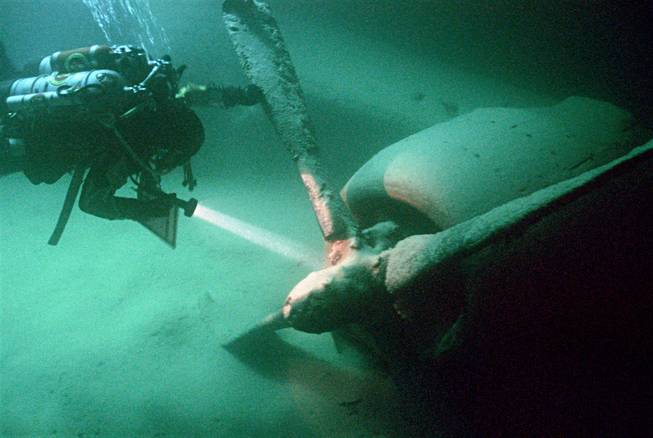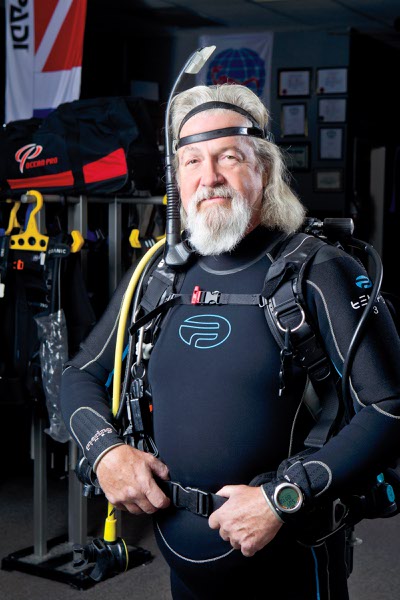
National Park Service
A SCUBA diver explores the WWII B29 bomber submerged at the bottom of Lake Mead.
Sunday, Aug. 17, 2014 | 2 a.m.
Places to dive at Hoover Dam
• Hoover Dam wall dive: Follow the terraced lake wall of Hoover Dam as you descend toward the bottom more than 500 feet down. It’s good for both beginning and advanced divers.
• The crack: Swim around tall sandstone spires that rise from a crevasse in Lake Mead’s bottom. A deeper dive, about 30 minutes by boat from the Lake Mead marina, it is best suited for advanced divers.
• Boulder Islands: Dive near the lake’s batch plant, originally an aggregate washing facility for the concrete used to build Hoover Dam. Railroad tracks still can be found below the factory. Aquatic life in the area includes freshwater sponges, catfish and bluegill.
Day trips
• Shaw’s Cove: Part of a marine preserve near Laguna Beach, Calif., this area teems with fish. A cove protects the beach from big swells, and the dive isn’t deep, making it a good spot for beginners. “It’s gorgeous down there,” Bill Duckro said.
• Sand Hollow in Utah: This reservoir, a two-hour drive from Las Vegas, is home to a sunken bus and sunken plane. “These big bass come right up to you,” Duckro said. “They aren’t scared at all.”
I sank slowly beneath Lake Mead’s surface in early December, submerging into the 50-degree water. My head began to throb. It was the worst ice-cream headache I had ever experienced.
I was taking the last class standing between me and open water scuba certification — and a trip to the warm waters of the Mexican Riviera.
The first steps to scuba certification seemed daunting: the cost, learning how your body reacts to the underwater world, getting used to the equipment, practicing how to stay safe.
I thought the turquoise waters of the Caribbean would be my reward for the gulp of lake water I took down during my first dive in Lake Mead. “Just get past this frigid last dive,” I told myself.
But before I had time even to decide if my frozen cranium was something to be concerned about, I already had forgotten it. We were underwater, exploring the lake bed, circling a sunken row boat and floating weightlessly as fish cruised by.
Past the stress and tension of first-time jitters, scuba diving is a relaxing escape, a window into a largely unexplored and unseen world, a chance to defy our own physiology and live for brief moments in a place where the opportunities for discovery seem endless.
Oh, yeah. That trip to Mexico was a pretty great graduation present, too.
See a different side of the lake
One of the best freshwater diving sites on the planet lies in Las Vegas’ backyard, but few appreciate it.
That’s the view of local scuba instructor Bill Duckro, who says Lake Mead is vastly underrated as a place to dive.
The lake is home to a variety of fish, including bluegill, large- and smallmouth bass, striped bass, catfish and carp, and offers all kinds of man-made items begging to be explored, from old railroad tracks and boats to a World War II-era bomber and construction equipment used to build the Hoover Dam.
“Lake Mead is considered one of the top freshwater dives in the whole world,” said Duckro, who runs Scuba Views dive shop.
Duckro fell in love with diving when he was 51 , after trying it in Cabo San Lucas with his brother. Now 67, Duckro estimates he has made more than 6,000 dives, completing 350 to 500 a year.
“So many people consider Lake Mead a dirty lake, and they don’t want to dive in it,” he said. “They don’t understand. They go out in the summer, and once the lake temperature hits 72 degrees, the algae blooms start. Under that layer of algae, down 10 or 15 feet, it’s clear. Wintertime is the best. It’s clear, and there’s up to 70 feet of visibility.”
Duckro’s son Eric, who followed his father into scuba, said diving is “the closest you can get to flying without an airplane.”
“To pinpoint one thing (I like) is like asking what your favorite bite of the sandwich is,” he said. “I just like the entire experience from start to finish.”
What beginners can expect
Equipment
There are several basic pieces of equipment every diver uses:
• Fins for propulsion
• Booties keep feet warm and minimize chafing from fins
• Cylinder holds the compressed air that a diver breathes. Also commonly called the tank. In more advanced diving, enriched air, which has a higher amount of oxygen, is sometimes used.
• Regulator allows divers to breathe pressurized air coming from their cylinders.
• Wetsuit provides warmth and protection from scrapes, abrasions and stings underwater. The thickness of the material is measured in millimeters, with thicker suits offering more warmth. A 2 to 5mm suit is sufficient for most dives, but divers may step up to a 7 to 10mm suit when water temperatures dip below 60 degrees.
• Buoyancy control device, or BC, is an expandable bladder, commonly part of a vest, that can be inflated and deflated with a button to control buoyancy. The tank is strapped to the BC and gauges and hoses are attached.
• Gauges show a diver’s depth and how much air remains in the tank. Some gauge systems also include compasses and clocks.
• Weight belt, snorkel, mask
Wanna try?
There are several stores in the valley that offer scuba lessons, gear and dives. Among them:
• Scuba Views: 3220 N. Rancho Drive, Las Vegas, 702-645-0516, scubaviews.com
• Gr8 Divn: 101 S. Rainbow Blvd., Suite 11, Las Vegas, 702-367-3484, gr8divn.com
• AAI Neptune Divers: 5831 E. Lake Mead Blvd., Las Vegas, 702-452-5723, firstchoicediving.com
• Dive Into Fun: 50 N. Gibson Road, Suite 170, Henderson, 702-479-7900, diveintofun.com
• Education: Obtaining an open-water scuba certification, which is required for diving independently and renting equipment, requires completion of at least four instruction sessions.
First is a class in which the instructor goes over equipment, effects of pressure on the body, safety, hand signals and other information. Next, students practice basic scuba skills in a swimming pool. Finally, students complete at least two open-water dives, usually with two dives per session. In some cases, students need additional classes, depending on how quickly they pick up the skills and how comfortable they feel underwater.
• Cost: Generally, open-water scuba certification costs $200 to $400. When inquiring about cost, ask if equipment is provided with classes. Also, ask about the dive center’s policies on scheduling and cancellations.
Buying the equipment needed to scuba dive (see below) will run a minimum of several hundred dollars, depending on quality, and the most expensive kits cost thousands. Some dive shops offer package deals that include basic equipment and open-water certification for one price. Renting equipment for a day typically costs $50 to $75.
• Certification: There are several scuba certification organizations worldwide, including Professional Association of Dive Instructors (PADI), National Association of Underwater Instructors (NAUI), Scuba Schools International (SSI) and Scuba Diving International (SDI). Don’t get lost in the alphabet soup. As long as they belong to the Recreational Scuba Training Council, they will follow an established system for what every diver must learn before certification.
Under PADI, children as young as 10 can participate in adult-supervised diving. The minimum age for open-water scuba certification is 15. Students should possess basic swimming skills and be comfortable in the water. Divers will be required to fill out a medical questionnaire.
Advanced certification
In addition to open water dive certification for recreational diving down to 130 feet, there are many advanced courses. The deeper a diver goes and the more challenging an environment he or she faces, the greater the risk, so training is essential. “A small problem at 30 feet can be a catastrophic problem at 300 feet,” Eric Duckro said.
Beyond recreational dives
There are certification courses that train divers to plunge deeper than the recreational limit or dive in tricky environments such as caves and shipwrecks. Courses also are available for rescue diving, emergency first response, night diving, underwater filming and more.


Join the Discussion:
Check this out for a full explanation of our conversion to the LiveFyre commenting system and instructions on how to sign up for an account.
Full comments policy